Exploring Deductive vs. Inductive Reasoning in Human Cognition
VerifiedAdded on 2020/04/15
|11
|2843
|82
AI Summary
The essay delves into human reasoning through the lens of cognitive psychology, exploring subjective experiences shaped by schemas and scripts that vary across cultures. By contrasting these with artificial intelligence's methods of probabilistic inference, it highlights differences and potential intersections between human cognition and machine learning. The discussion includes an analysis of deductive versus inductive reasoning and their applications in understanding both natural and artificial processes. Through a synthesis of cognitive psychology insights and AI technology, the essay aims to provide a comprehensive perspective on how human reasoning can be understood and replicated by machines.
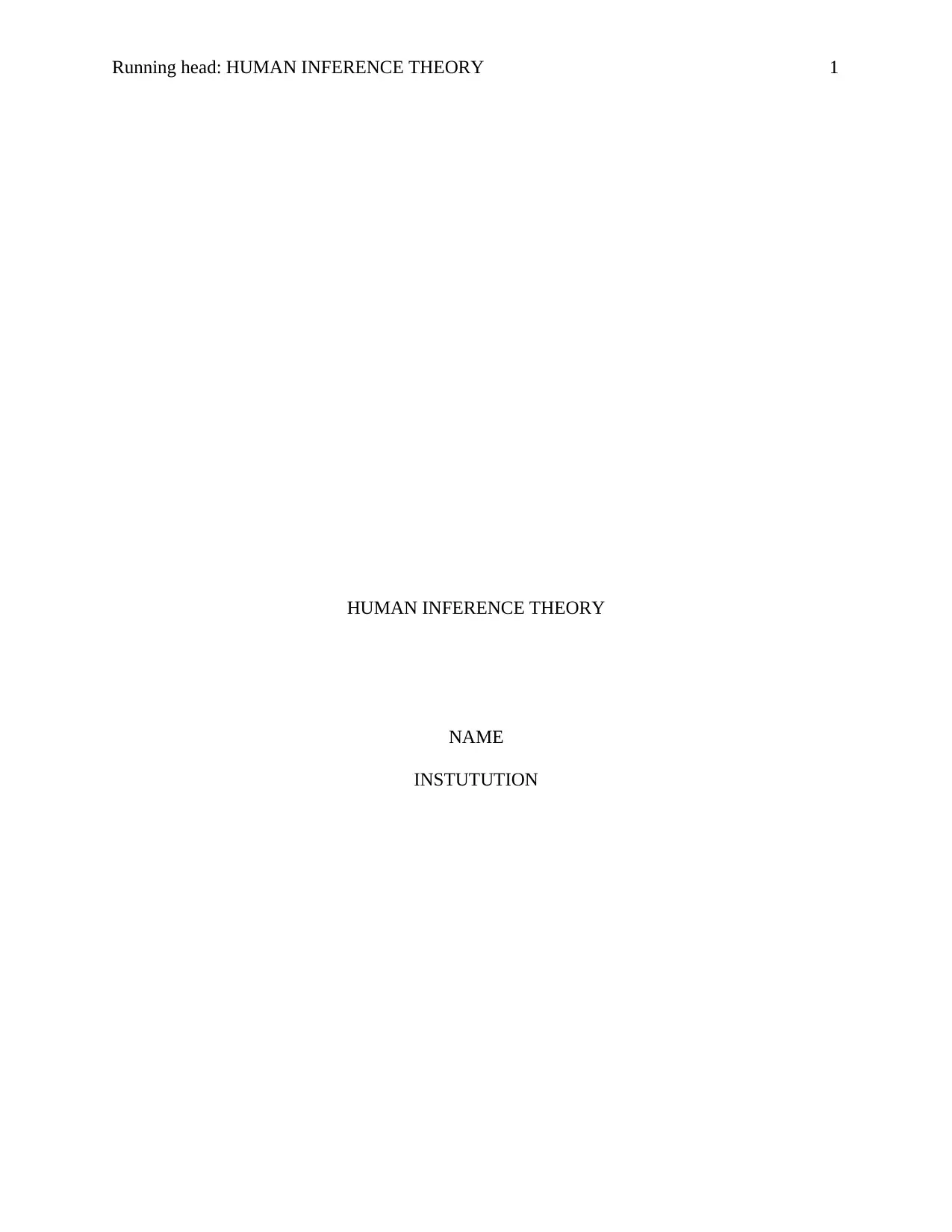
Running head: HUMAN INFERENCE THEORY 1
HUMAN INFERENCE THEORY
NAME
INSTUTUTION
HUMAN INFERENCE THEORY
NAME
INSTUTUTION
Paraphrase This Document
Need a fresh take? Get an instant paraphrase of this document with our AI Paraphraser
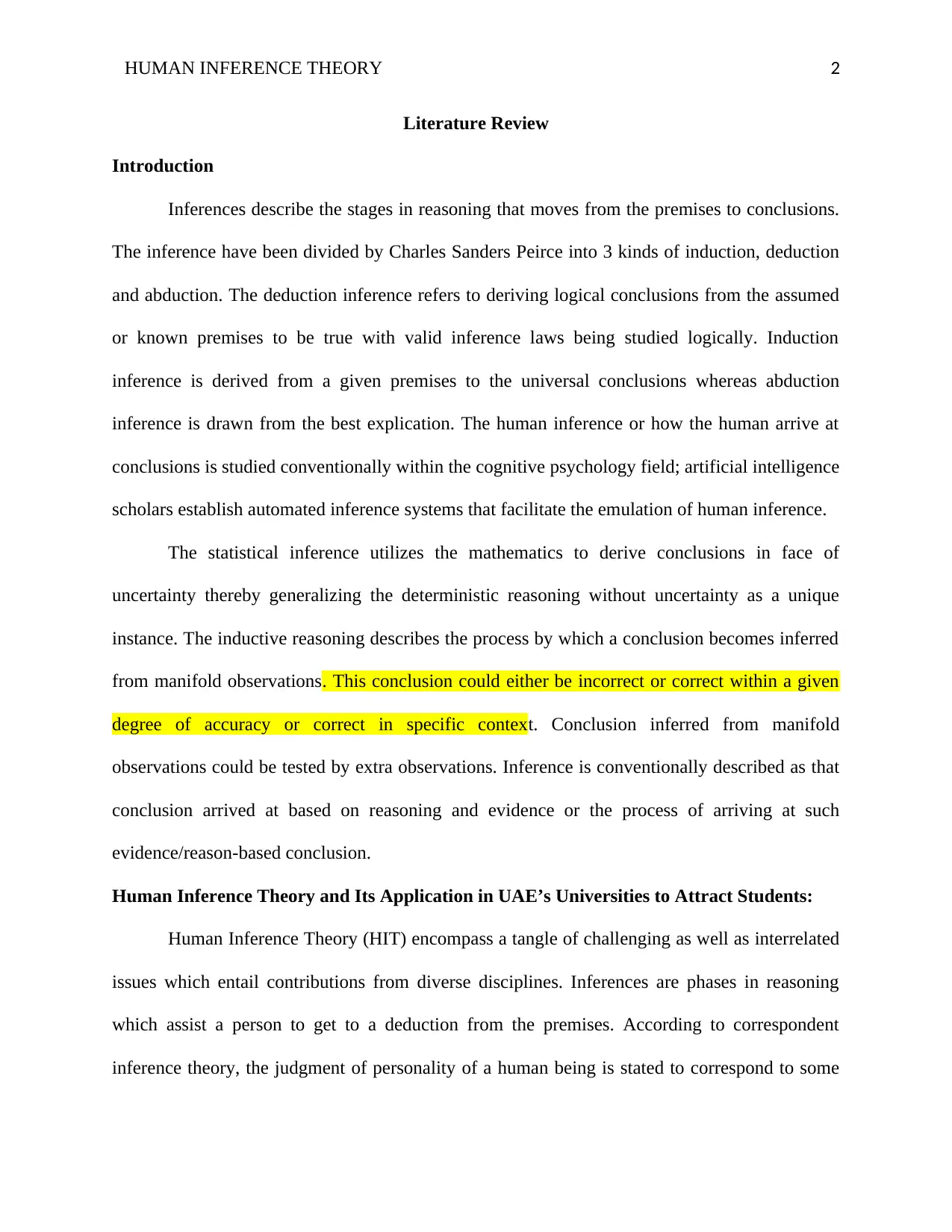
HUMAN INFERENCE THEORY 2
Literature Review
Introduction
Inferences describe the stages in reasoning that moves from the premises to conclusions.
The inference have been divided by Charles Sanders Peirce into 3 kinds of induction, deduction
and abduction. The deduction inference refers to deriving logical conclusions from the assumed
or known premises to be true with valid inference laws being studied logically. Induction
inference is derived from a given premises to the universal conclusions whereas abduction
inference is drawn from the best explication. The human inference or how the human arrive at
conclusions is studied conventionally within the cognitive psychology field; artificial intelligence
scholars establish automated inference systems that facilitate the emulation of human inference.
The statistical inference utilizes the mathematics to derive conclusions in face of
uncertainty thereby generalizing the deterministic reasoning without uncertainty as a unique
instance. The inductive reasoning describes the process by which a conclusion becomes inferred
from manifold observations. This conclusion could either be incorrect or correct within a given
degree of accuracy or correct in specific context. Conclusion inferred from manifold
observations could be tested by extra observations. Inference is conventionally described as that
conclusion arrived at based on reasoning and evidence or the process of arriving at such
evidence/reason-based conclusion.
Human Inference Theory and Its Application in UAE’s Universities to Attract Students:
Human Inference Theory (HIT) encompass a tangle of challenging as well as interrelated
issues which entail contributions from diverse disciplines. Inferences are phases in reasoning
which assist a person to get to a deduction from the premises. According to correspondent
inference theory, the judgment of personality of a human being is stated to correspond to some
Literature Review
Introduction
Inferences describe the stages in reasoning that moves from the premises to conclusions.
The inference have been divided by Charles Sanders Peirce into 3 kinds of induction, deduction
and abduction. The deduction inference refers to deriving logical conclusions from the assumed
or known premises to be true with valid inference laws being studied logically. Induction
inference is derived from a given premises to the universal conclusions whereas abduction
inference is drawn from the best explication. The human inference or how the human arrive at
conclusions is studied conventionally within the cognitive psychology field; artificial intelligence
scholars establish automated inference systems that facilitate the emulation of human inference.
The statistical inference utilizes the mathematics to derive conclusions in face of
uncertainty thereby generalizing the deterministic reasoning without uncertainty as a unique
instance. The inductive reasoning describes the process by which a conclusion becomes inferred
from manifold observations. This conclusion could either be incorrect or correct within a given
degree of accuracy or correct in specific context. Conclusion inferred from manifold
observations could be tested by extra observations. Inference is conventionally described as that
conclusion arrived at based on reasoning and evidence or the process of arriving at such
evidence/reason-based conclusion.
Human Inference Theory and Its Application in UAE’s Universities to Attract Students:
Human Inference Theory (HIT) encompass a tangle of challenging as well as interrelated
issues which entail contributions from diverse disciplines. Inferences are phases in reasoning
which assist a person to get to a deduction from the premises. According to correspondent
inference theory, the judgment of personality of a human being is stated to correspond to some
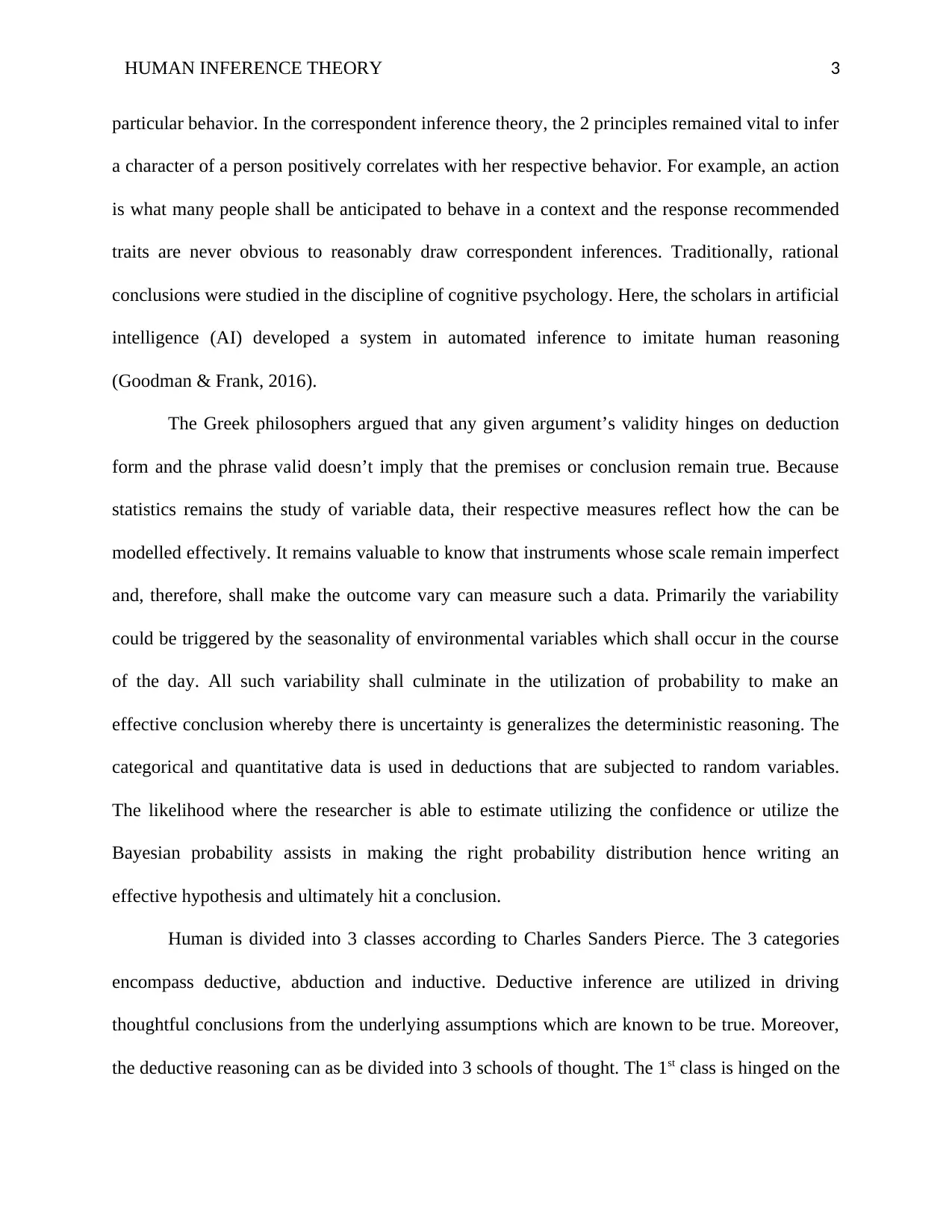
HUMAN INFERENCE THEORY 3
particular behavior. In the correspondent inference theory, the 2 principles remained vital to infer
a character of a person positively correlates with her respective behavior. For example, an action
is what many people shall be anticipated to behave in a context and the response recommended
traits are never obvious to reasonably draw correspondent inferences. Traditionally, rational
conclusions were studied in the discipline of cognitive psychology. Here, the scholars in artificial
intelligence (AI) developed a system in automated inference to imitate human reasoning
(Goodman & Frank, 2016).
The Greek philosophers argued that any given argument’s validity hinges on deduction
form and the phrase valid doesn’t imply that the premises or conclusion remain true. Because
statistics remains the study of variable data, their respective measures reflect how the can be
modelled effectively. It remains valuable to know that instruments whose scale remain imperfect
and, therefore, shall make the outcome vary can measure such a data. Primarily the variability
could be triggered by the seasonality of environmental variables which shall occur in the course
of the day. All such variability shall culminate in the utilization of probability to make an
effective conclusion whereby there is uncertainty is generalizes the deterministic reasoning. The
categorical and quantitative data is used in deductions that are subjected to random variables.
The likelihood where the researcher is able to estimate utilizing the confidence or utilize the
Bayesian probability assists in making the right probability distribution hence writing an
effective hypothesis and ultimately hit a conclusion.
Human is divided into 3 classes according to Charles Sanders Pierce. The 3 categories
encompass deductive, abduction and inductive. Deductive inference are utilized in driving
thoughtful conclusions from the underlying assumptions which are known to be true. Moreover,
the deductive reasoning can as be divided into 3 schools of thought. The 1st class is hinged on the
particular behavior. In the correspondent inference theory, the 2 principles remained vital to infer
a character of a person positively correlates with her respective behavior. For example, an action
is what many people shall be anticipated to behave in a context and the response recommended
traits are never obvious to reasonably draw correspondent inferences. Traditionally, rational
conclusions were studied in the discipline of cognitive psychology. Here, the scholars in artificial
intelligence (AI) developed a system in automated inference to imitate human reasoning
(Goodman & Frank, 2016).
The Greek philosophers argued that any given argument’s validity hinges on deduction
form and the phrase valid doesn’t imply that the premises or conclusion remain true. Because
statistics remains the study of variable data, their respective measures reflect how the can be
modelled effectively. It remains valuable to know that instruments whose scale remain imperfect
and, therefore, shall make the outcome vary can measure such a data. Primarily the variability
could be triggered by the seasonality of environmental variables which shall occur in the course
of the day. All such variability shall culminate in the utilization of probability to make an
effective conclusion whereby there is uncertainty is generalizes the deterministic reasoning. The
categorical and quantitative data is used in deductions that are subjected to random variables.
The likelihood where the researcher is able to estimate utilizing the confidence or utilize the
Bayesian probability assists in making the right probability distribution hence writing an
effective hypothesis and ultimately hit a conclusion.
Human is divided into 3 classes according to Charles Sanders Pierce. The 3 categories
encompass deductive, abduction and inductive. Deductive inference are utilized in driving
thoughtful conclusions from the underlying assumptions which are known to be true. Moreover,
the deductive reasoning can as be divided into 3 schools of thought. The 1st class is hinged on the
⊘ This is a preview!⊘
Do you want full access?
Subscribe today to unlock all pages.

Trusted by 1+ million students worldwide
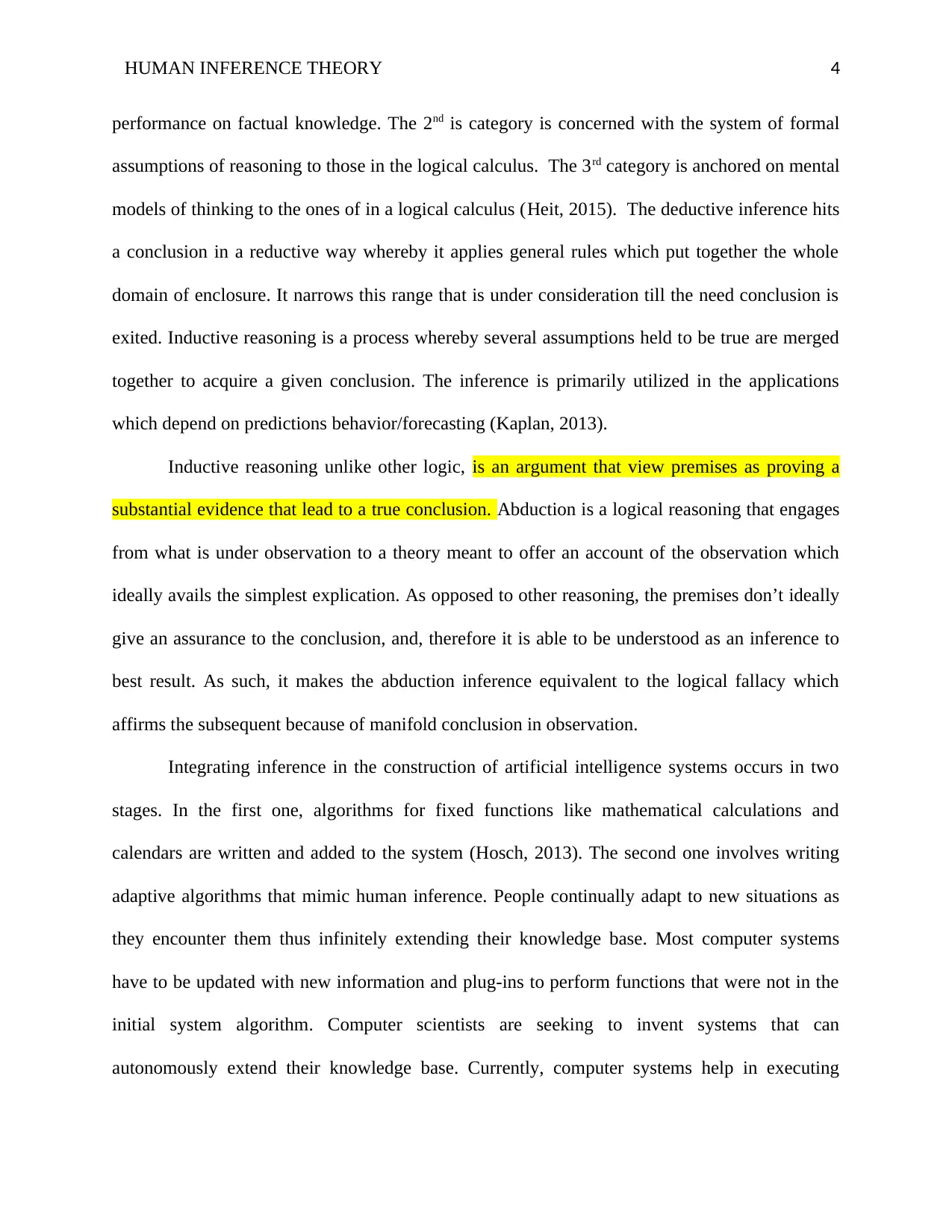
HUMAN INFERENCE THEORY 4
performance on factual knowledge. The 2nd is category is concerned with the system of formal
assumptions of reasoning to those in the logical calculus. The 3rd category is anchored on mental
models of thinking to the ones of in a logical calculus (Heit, 2015). The deductive inference hits
a conclusion in a reductive way whereby it applies general rules which put together the whole
domain of enclosure. It narrows this range that is under consideration till the need conclusion is
exited. Inductive reasoning is a process whereby several assumptions held to be true are merged
together to acquire a given conclusion. The inference is primarily utilized in the applications
which depend on predictions behavior/forecasting (Kaplan, 2013).
Inductive reasoning unlike other logic, is an argument that view premises as proving a
substantial evidence that lead to a true conclusion. Abduction is a logical reasoning that engages
from what is under observation to a theory meant to offer an account of the observation which
ideally avails the simplest explication. As opposed to other reasoning, the premises don’t ideally
give an assurance to the conclusion, and, therefore it is able to be understood as an inference to
best result. As such, it makes the abduction inference equivalent to the logical fallacy which
affirms the subsequent because of manifold conclusion in observation.
Integrating inference in the construction of artificial intelligence systems occurs in two
stages. In the first one, algorithms for fixed functions like mathematical calculations and
calendars are written and added to the system (Hosch, 2013). The second one involves writing
adaptive algorithms that mimic human inference. People continually adapt to new situations as
they encounter them thus infinitely extending their knowledge base. Most computer systems
have to be updated with new information and plug-ins to perform functions that were not in the
initial system algorithm. Computer scientists are seeking to invent systems that can
autonomously extend their knowledge base. Currently, computer systems help in executing
performance on factual knowledge. The 2nd is category is concerned with the system of formal
assumptions of reasoning to those in the logical calculus. The 3rd category is anchored on mental
models of thinking to the ones of in a logical calculus (Heit, 2015). The deductive inference hits
a conclusion in a reductive way whereby it applies general rules which put together the whole
domain of enclosure. It narrows this range that is under consideration till the need conclusion is
exited. Inductive reasoning is a process whereby several assumptions held to be true are merged
together to acquire a given conclusion. The inference is primarily utilized in the applications
which depend on predictions behavior/forecasting (Kaplan, 2013).
Inductive reasoning unlike other logic, is an argument that view premises as proving a
substantial evidence that lead to a true conclusion. Abduction is a logical reasoning that engages
from what is under observation to a theory meant to offer an account of the observation which
ideally avails the simplest explication. As opposed to other reasoning, the premises don’t ideally
give an assurance to the conclusion, and, therefore it is able to be understood as an inference to
best result. As such, it makes the abduction inference equivalent to the logical fallacy which
affirms the subsequent because of manifold conclusion in observation.
Integrating inference in the construction of artificial intelligence systems occurs in two
stages. In the first one, algorithms for fixed functions like mathematical calculations and
calendars are written and added to the system (Hosch, 2013). The second one involves writing
adaptive algorithms that mimic human inference. People continually adapt to new situations as
they encounter them thus infinitely extending their knowledge base. Most computer systems
have to be updated with new information and plug-ins to perform functions that were not in the
initial system algorithm. Computer scientists are seeking to invent systems that can
autonomously extend their knowledge base. Currently, computer systems help in executing
Paraphrase This Document
Need a fresh take? Get an instant paraphrase of this document with our AI Paraphraser
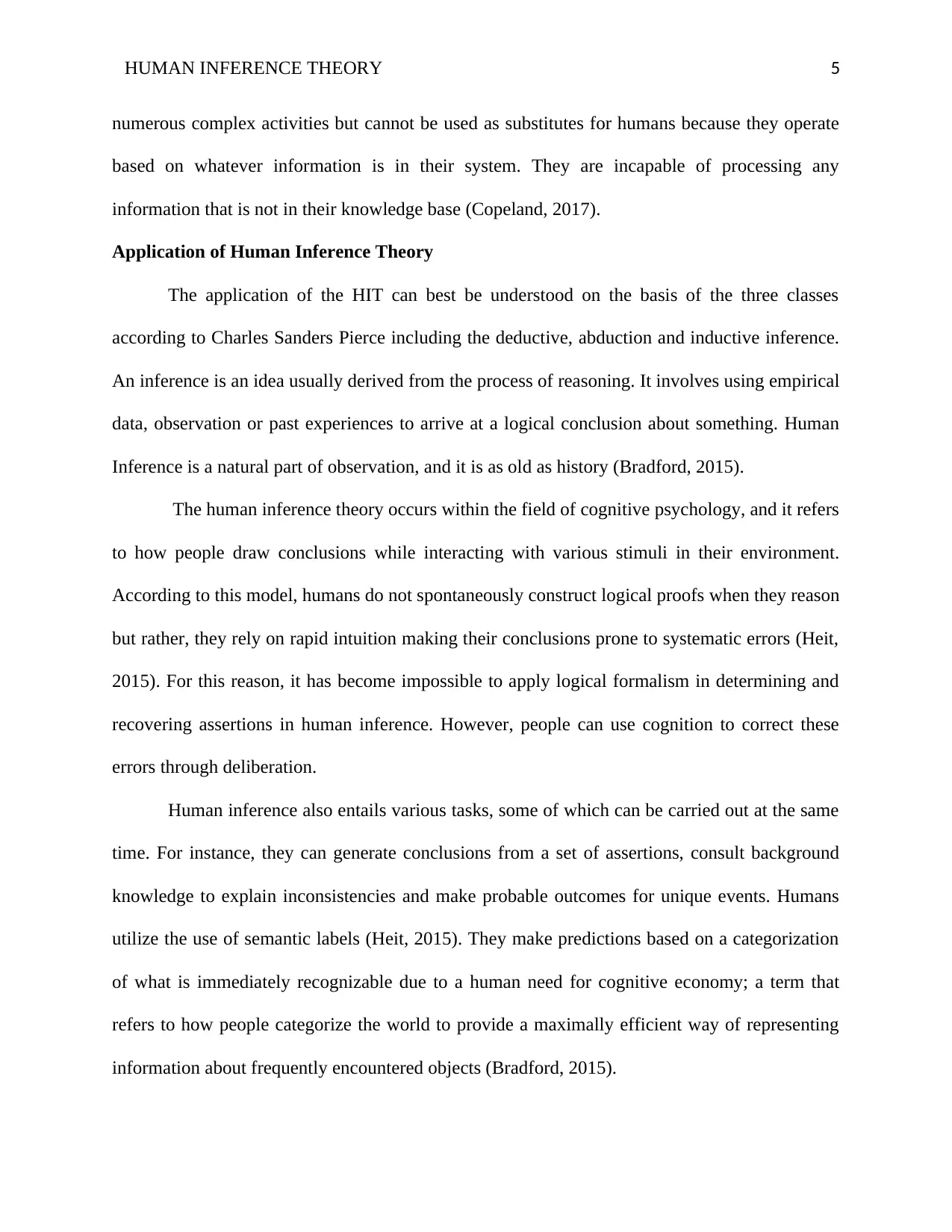
HUMAN INFERENCE THEORY 5
numerous complex activities but cannot be used as substitutes for humans because they operate
based on whatever information is in their system. They are incapable of processing any
information that is not in their knowledge base (Copeland, 2017).
Application of Human Inference Theory
The application of the HIT can best be understood on the basis of the three classes
according to Charles Sanders Pierce including the deductive, abduction and inductive inference.
An inference is an idea usually derived from the process of reasoning. It involves using empirical
data, observation or past experiences to arrive at a logical conclusion about something. Human
Inference is a natural part of observation, and it is as old as history (Bradford, 2015).
The human inference theory occurs within the field of cognitive psychology, and it refers
to how people draw conclusions while interacting with various stimuli in their environment.
According to this model, humans do not spontaneously construct logical proofs when they reason
but rather, they rely on rapid intuition making their conclusions prone to systematic errors (Heit,
2015). For this reason, it has become impossible to apply logical formalism in determining and
recovering assertions in human inference. However, people can use cognition to correct these
errors through deliberation.
Human inference also entails various tasks, some of which can be carried out at the same
time. For instance, they can generate conclusions from a set of assertions, consult background
knowledge to explain inconsistencies and make probable outcomes for unique events. Humans
utilize the use of semantic labels (Heit, 2015). They make predictions based on a categorization
of what is immediately recognizable due to a human need for cognitive economy; a term that
refers to how people categorize the world to provide a maximally efficient way of representing
information about frequently encountered objects (Bradford, 2015).
numerous complex activities but cannot be used as substitutes for humans because they operate
based on whatever information is in their system. They are incapable of processing any
information that is not in their knowledge base (Copeland, 2017).
Application of Human Inference Theory
The application of the HIT can best be understood on the basis of the three classes
according to Charles Sanders Pierce including the deductive, abduction and inductive inference.
An inference is an idea usually derived from the process of reasoning. It involves using empirical
data, observation or past experiences to arrive at a logical conclusion about something. Human
Inference is a natural part of observation, and it is as old as history (Bradford, 2015).
The human inference theory occurs within the field of cognitive psychology, and it refers
to how people draw conclusions while interacting with various stimuli in their environment.
According to this model, humans do not spontaneously construct logical proofs when they reason
but rather, they rely on rapid intuition making their conclusions prone to systematic errors (Heit,
2015). For this reason, it has become impossible to apply logical formalism in determining and
recovering assertions in human inference. However, people can use cognition to correct these
errors through deliberation.
Human inference also entails various tasks, some of which can be carried out at the same
time. For instance, they can generate conclusions from a set of assertions, consult background
knowledge to explain inconsistencies and make probable outcomes for unique events. Humans
utilize the use of semantic labels (Heit, 2015). They make predictions based on a categorization
of what is immediately recognizable due to a human need for cognitive economy; a term that
refers to how people categorize the world to provide a maximally efficient way of representing
information about frequently encountered objects (Bradford, 2015).
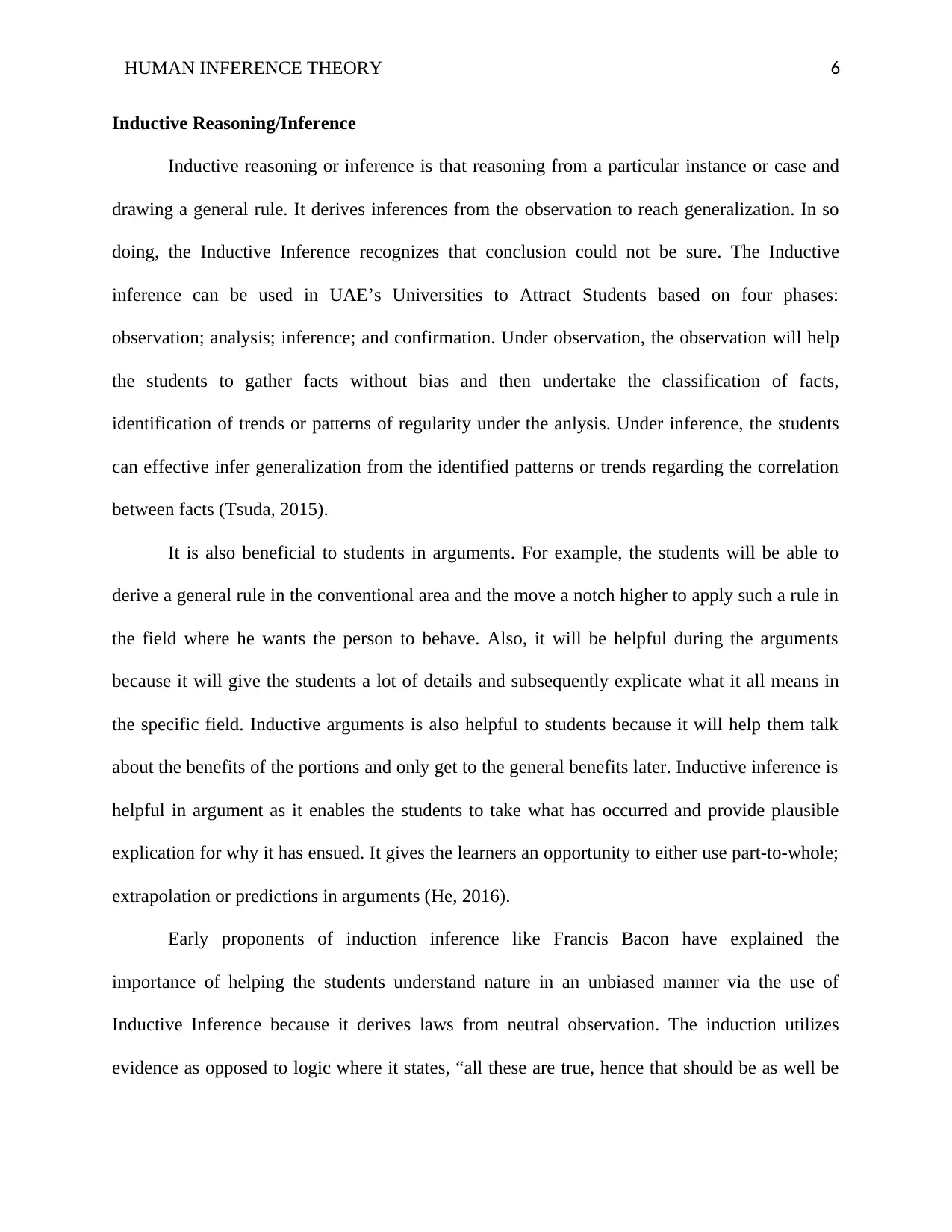
HUMAN INFERENCE THEORY 6
Inductive Reasoning/Inference
Inductive reasoning or inference is that reasoning from a particular instance or case and
drawing a general rule. It derives inferences from the observation to reach generalization. In so
doing, the Inductive Inference recognizes that conclusion could not be sure. The Inductive
inference can be used in UAE’s Universities to Attract Students based on four phases:
observation; analysis; inference; and confirmation. Under observation, the observation will help
the students to gather facts without bias and then undertake the classification of facts,
identification of trends or patterns of regularity under the anlysis. Under inference, the students
can effective infer generalization from the identified patterns or trends regarding the correlation
between facts (Tsuda, 2015).
It is also beneficial to students in arguments. For example, the students will be able to
derive a general rule in the conventional area and the move a notch higher to apply such a rule in
the field where he wants the person to behave. Also, it will be helpful during the arguments
because it will give the students a lot of details and subsequently explicate what it all means in
the specific field. Inductive arguments is also helpful to students because it will help them talk
about the benefits of the portions and only get to the general benefits later. Inductive inference is
helpful in argument as it enables the students to take what has occurred and provide plausible
explication for why it has ensued. It gives the learners an opportunity to either use part-to-whole;
extrapolation or predictions in arguments (He, 2016).
Early proponents of induction inference like Francis Bacon have explained the
importance of helping the students understand nature in an unbiased manner via the use of
Inductive Inference because it derives laws from neutral observation. The induction utilizes
evidence as opposed to logic where it states, “all these are true, hence that should be as well be
Inductive Reasoning/Inference
Inductive reasoning or inference is that reasoning from a particular instance or case and
drawing a general rule. It derives inferences from the observation to reach generalization. In so
doing, the Inductive Inference recognizes that conclusion could not be sure. The Inductive
inference can be used in UAE’s Universities to Attract Students based on four phases:
observation; analysis; inference; and confirmation. Under observation, the observation will help
the students to gather facts without bias and then undertake the classification of facts,
identification of trends or patterns of regularity under the anlysis. Under inference, the students
can effective infer generalization from the identified patterns or trends regarding the correlation
between facts (Tsuda, 2015).
It is also beneficial to students in arguments. For example, the students will be able to
derive a general rule in the conventional area and the move a notch higher to apply such a rule in
the field where he wants the person to behave. Also, it will be helpful during the arguments
because it will give the students a lot of details and subsequently explicate what it all means in
the specific field. Inductive arguments is also helpful to students because it will help them talk
about the benefits of the portions and only get to the general benefits later. Inductive inference is
helpful in argument as it enables the students to take what has occurred and provide plausible
explication for why it has ensued. It gives the learners an opportunity to either use part-to-whole;
extrapolation or predictions in arguments (He, 2016).
Early proponents of induction inference like Francis Bacon have explained the
importance of helping the students understand nature in an unbiased manner via the use of
Inductive Inference because it derives laws from neutral observation. The induction utilizes
evidence as opposed to logic where it states, “all these are true, hence that should be as well be
⊘ This is a preview!⊘
Do you want full access?
Subscribe today to unlock all pages.

Trusted by 1+ million students worldwide
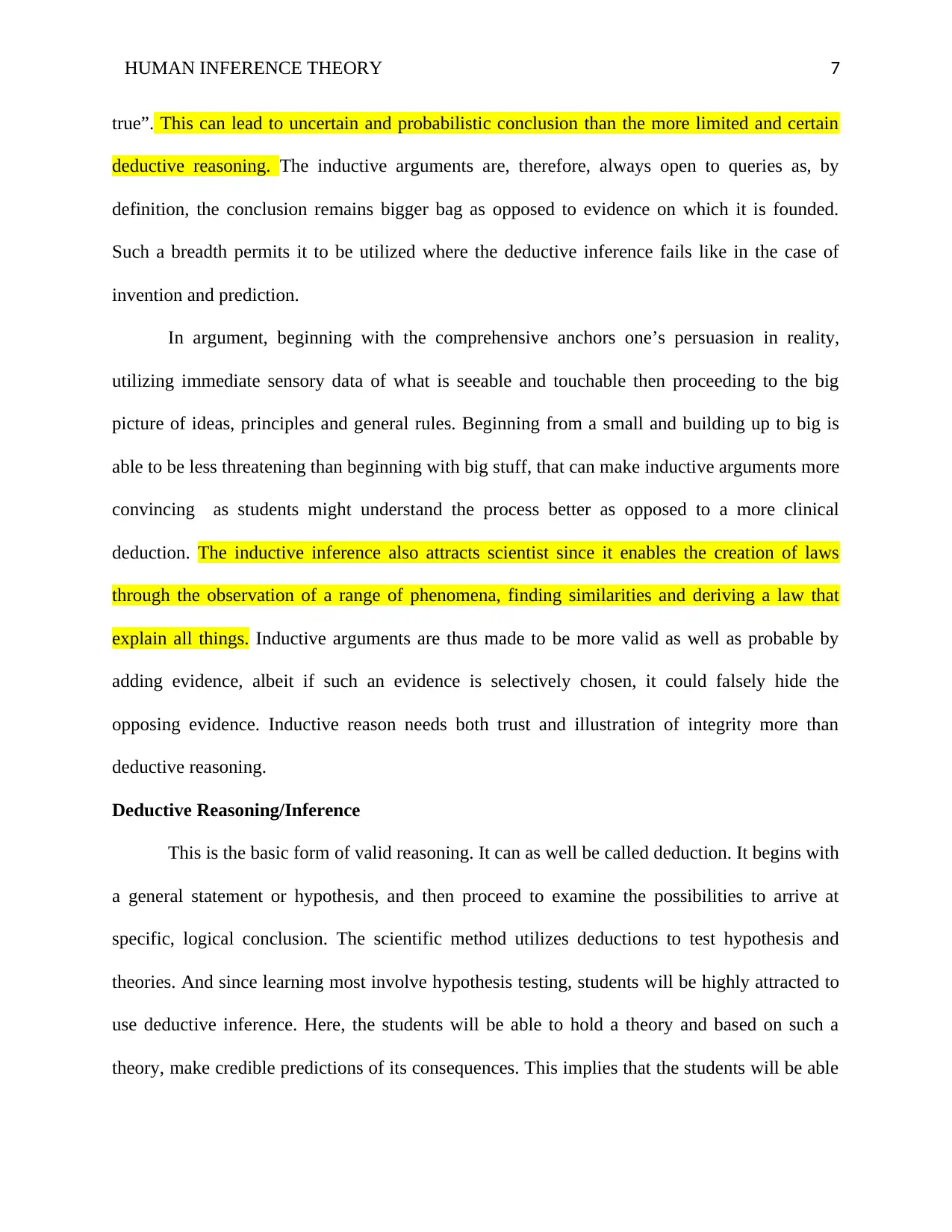
HUMAN INFERENCE THEORY 7
true”. This can lead to uncertain and probabilistic conclusion than the more limited and certain
deductive reasoning. The inductive arguments are, therefore, always open to queries as, by
definition, the conclusion remains bigger bag as opposed to evidence on which it is founded.
Such a breadth permits it to be utilized where the deductive inference fails like in the case of
invention and prediction.
In argument, beginning with the comprehensive anchors one’s persuasion in reality,
utilizing immediate sensory data of what is seeable and touchable then proceeding to the big
picture of ideas, principles and general rules. Beginning from a small and building up to big is
able to be less threatening than beginning with big stuff, that can make inductive arguments more
convincing as students might understand the process better as opposed to a more clinical
deduction. The inductive inference also attracts scientist since it enables the creation of laws
through the observation of a range of phenomena, finding similarities and deriving a law that
explain all things. Inductive arguments are thus made to be more valid as well as probable by
adding evidence, albeit if such an evidence is selectively chosen, it could falsely hide the
opposing evidence. Inductive reason needs both trust and illustration of integrity more than
deductive reasoning.
Deductive Reasoning/Inference
This is the basic form of valid reasoning. It can as well be called deduction. It begins with
a general statement or hypothesis, and then proceed to examine the possibilities to arrive at
specific, logical conclusion. The scientific method utilizes deductions to test hypothesis and
theories. And since learning most involve hypothesis testing, students will be highly attracted to
use deductive inference. Here, the students will be able to hold a theory and based on such a
theory, make credible predictions of its consequences. This implies that the students will be able
true”. This can lead to uncertain and probabilistic conclusion than the more limited and certain
deductive reasoning. The inductive arguments are, therefore, always open to queries as, by
definition, the conclusion remains bigger bag as opposed to evidence on which it is founded.
Such a breadth permits it to be utilized where the deductive inference fails like in the case of
invention and prediction.
In argument, beginning with the comprehensive anchors one’s persuasion in reality,
utilizing immediate sensory data of what is seeable and touchable then proceeding to the big
picture of ideas, principles and general rules. Beginning from a small and building up to big is
able to be less threatening than beginning with big stuff, that can make inductive arguments more
convincing as students might understand the process better as opposed to a more clinical
deduction. The inductive inference also attracts scientist since it enables the creation of laws
through the observation of a range of phenomena, finding similarities and deriving a law that
explain all things. Inductive arguments are thus made to be more valid as well as probable by
adding evidence, albeit if such an evidence is selectively chosen, it could falsely hide the
opposing evidence. Inductive reason needs both trust and illustration of integrity more than
deductive reasoning.
Deductive Reasoning/Inference
This is the basic form of valid reasoning. It can as well be called deduction. It begins with
a general statement or hypothesis, and then proceed to examine the possibilities to arrive at
specific, logical conclusion. The scientific method utilizes deductions to test hypothesis and
theories. And since learning most involve hypothesis testing, students will be highly attracted to
use deductive inference. Here, the students will be able to hold a theory and based on such a
theory, make credible predictions of its consequences. This implies that the students will be able
Paraphrase This Document
Need a fresh take? Get an instant paraphrase of this document with our AI Paraphraser
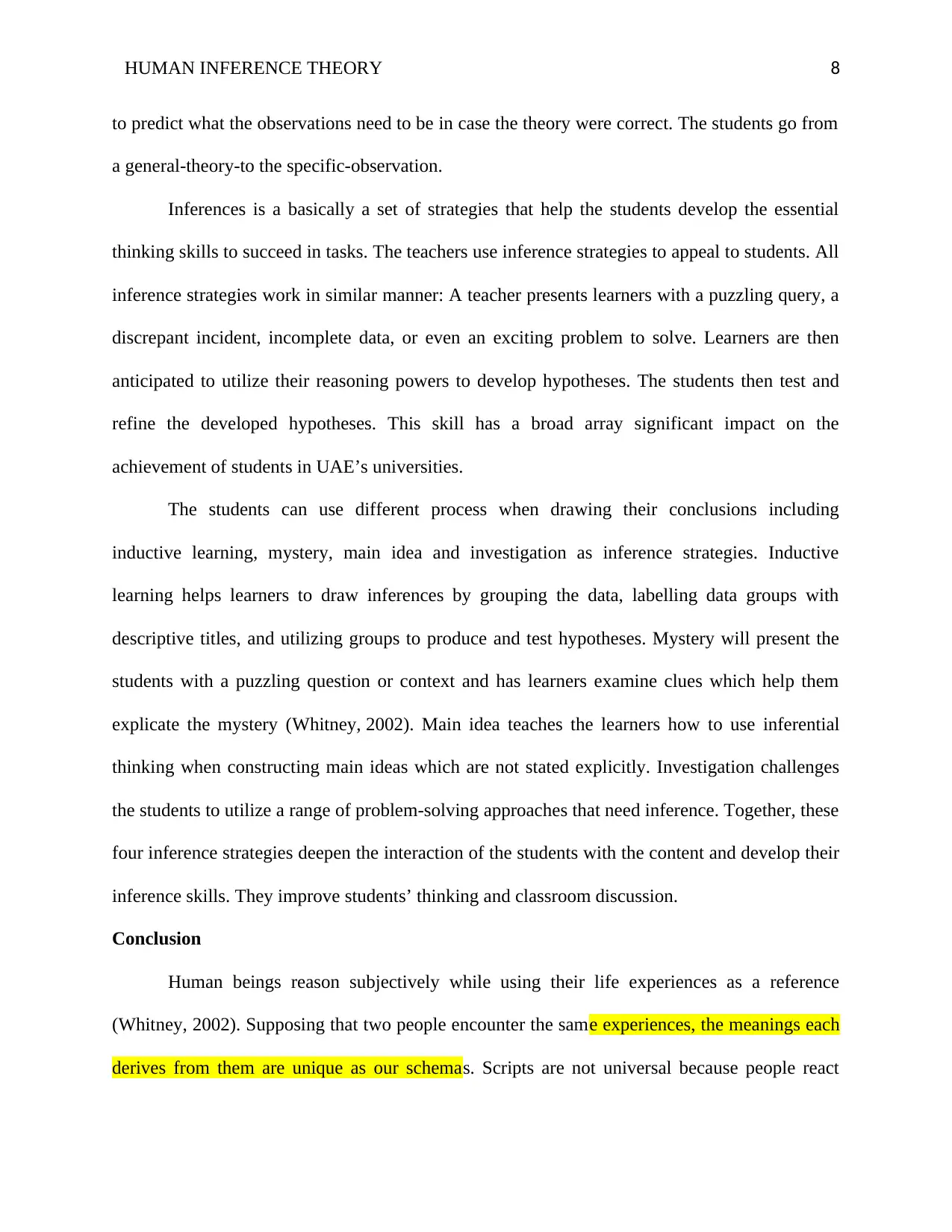
HUMAN INFERENCE THEORY 8
to predict what the observations need to be in case the theory were correct. The students go from
a general-theory-to the specific-observation.
Inferences is a basically a set of strategies that help the students develop the essential
thinking skills to succeed in tasks. The teachers use inference strategies to appeal to students. All
inference strategies work in similar manner: A teacher presents learners with a puzzling query, a
discrepant incident, incomplete data, or even an exciting problem to solve. Learners are then
anticipated to utilize their reasoning powers to develop hypotheses. The students then test and
refine the developed hypotheses. This skill has a broad array significant impact on the
achievement of students in UAE’s universities.
The students can use different process when drawing their conclusions including
inductive learning, mystery, main idea and investigation as inference strategies. Inductive
learning helps learners to draw inferences by grouping the data, labelling data groups with
descriptive titles, and utilizing groups to produce and test hypotheses. Mystery will present the
students with a puzzling question or context and has learners examine clues which help them
explicate the mystery (Whitney, 2002). Main idea teaches the learners how to use inferential
thinking when constructing main ideas which are not stated explicitly. Investigation challenges
the students to utilize a range of problem-solving approaches that need inference. Together, these
four inference strategies deepen the interaction of the students with the content and develop their
inference skills. They improve students’ thinking and classroom discussion.
Conclusion
Human beings reason subjectively while using their life experiences as a reference
(Whitney, 2002). Supposing that two people encounter the same experiences, the meanings each
derives from them are unique as our schemas. Scripts are not universal because people react
to predict what the observations need to be in case the theory were correct. The students go from
a general-theory-to the specific-observation.
Inferences is a basically a set of strategies that help the students develop the essential
thinking skills to succeed in tasks. The teachers use inference strategies to appeal to students. All
inference strategies work in similar manner: A teacher presents learners with a puzzling query, a
discrepant incident, incomplete data, or even an exciting problem to solve. Learners are then
anticipated to utilize their reasoning powers to develop hypotheses. The students then test and
refine the developed hypotheses. This skill has a broad array significant impact on the
achievement of students in UAE’s universities.
The students can use different process when drawing their conclusions including
inductive learning, mystery, main idea and investigation as inference strategies. Inductive
learning helps learners to draw inferences by grouping the data, labelling data groups with
descriptive titles, and utilizing groups to produce and test hypotheses. Mystery will present the
students with a puzzling question or context and has learners examine clues which help them
explicate the mystery (Whitney, 2002). Main idea teaches the learners how to use inferential
thinking when constructing main ideas which are not stated explicitly. Investigation challenges
the students to utilize a range of problem-solving approaches that need inference. Together, these
four inference strategies deepen the interaction of the students with the content and develop their
inference skills. They improve students’ thinking and classroom discussion.
Conclusion
Human beings reason subjectively while using their life experiences as a reference
(Whitney, 2002). Supposing that two people encounter the same experiences, the meanings each
derives from them are unique as our schemas. Scripts are not universal because people react
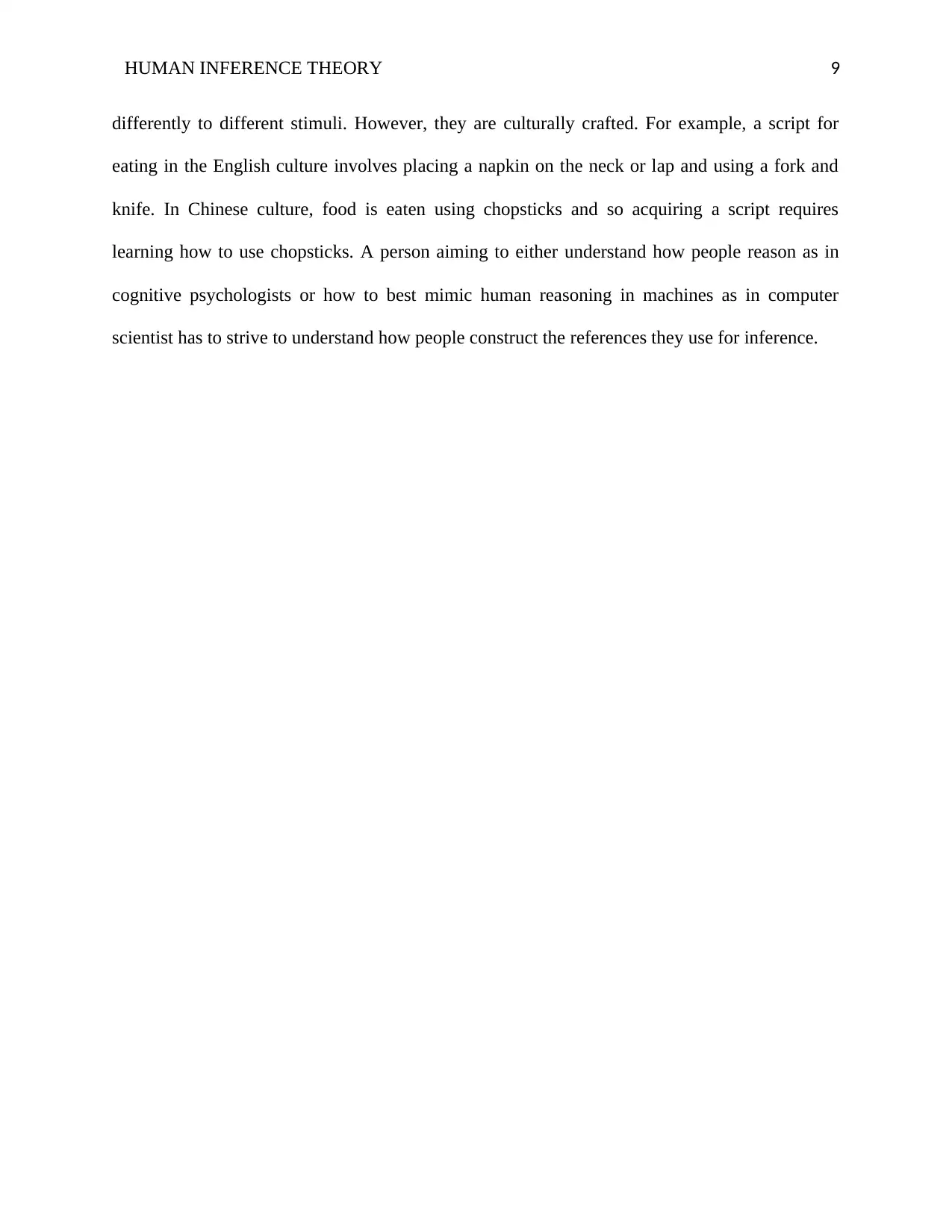
HUMAN INFERENCE THEORY 9
differently to different stimuli. However, they are culturally crafted. For example, a script for
eating in the English culture involves placing a napkin on the neck or lap and using a fork and
knife. In Chinese culture, food is eaten using chopsticks and so acquiring a script requires
learning how to use chopsticks. A person aiming to either understand how people reason as in
cognitive psychologists or how to best mimic human reasoning in machines as in computer
scientist has to strive to understand how people construct the references they use for inference.
differently to different stimuli. However, they are culturally crafted. For example, a script for
eating in the English culture involves placing a napkin on the neck or lap and using a fork and
knife. In Chinese culture, food is eaten using chopsticks and so acquiring a script requires
learning how to use chopsticks. A person aiming to either understand how people reason as in
cognitive psychologists or how to best mimic human reasoning in machines as in computer
scientist has to strive to understand how people construct the references they use for inference.
⊘ This is a preview!⊘
Do you want full access?
Subscribe today to unlock all pages.

Trusted by 1+ million students worldwide
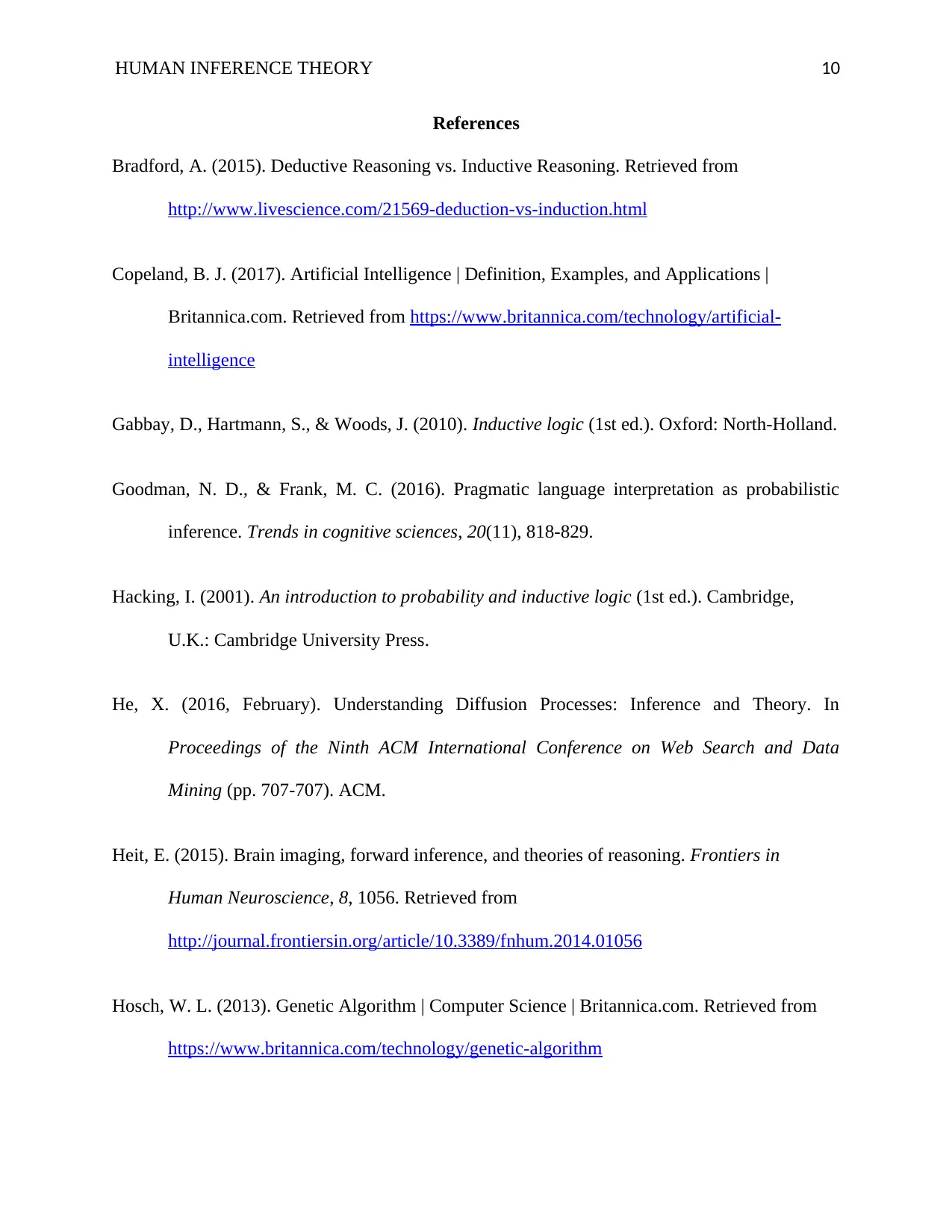
HUMAN INFERENCE THEORY 10
References
Bradford, A. (2015). Deductive Reasoning vs. Inductive Reasoning. Retrieved from
http://www.livescience.com/21569-deduction-vs-induction.html
Copeland, B. J. (2017). Artificial Intelligence | Definition, Examples, and Applications |
Britannica.com. Retrieved from https://www.britannica.com/technology/artificial-
intelligence
Gabbay, D., Hartmann, S., & Woods, J. (2010). Inductive logic (1st ed.). Oxford: North-Holland.
Goodman, N. D., & Frank, M. C. (2016). Pragmatic language interpretation as probabilistic
inference. Trends in cognitive sciences, 20(11), 818-829.
Hacking, I. (2001). An introduction to probability and inductive logic (1st ed.). Cambridge,
U.K.: Cambridge University Press.
He, X. (2016, February). Understanding Diffusion Processes: Inference and Theory. In
Proceedings of the Ninth ACM International Conference on Web Search and Data
Mining (pp. 707-707). ACM.
Heit, E. (2015). Brain imaging, forward inference, and theories of reasoning. Frontiers in
Human Neuroscience, 8, 1056. Retrieved from
http://journal.frontiersin.org/article/10.3389/fnhum.2014.01056
Hosch, W. L. (2013). Genetic Algorithm | Computer Science | Britannica.com. Retrieved from
https://www.britannica.com/technology/genetic-algorithm
References
Bradford, A. (2015). Deductive Reasoning vs. Inductive Reasoning. Retrieved from
http://www.livescience.com/21569-deduction-vs-induction.html
Copeland, B. J. (2017). Artificial Intelligence | Definition, Examples, and Applications |
Britannica.com. Retrieved from https://www.britannica.com/technology/artificial-
intelligence
Gabbay, D., Hartmann, S., & Woods, J. (2010). Inductive logic (1st ed.). Oxford: North-Holland.
Goodman, N. D., & Frank, M. C. (2016). Pragmatic language interpretation as probabilistic
inference. Trends in cognitive sciences, 20(11), 818-829.
Hacking, I. (2001). An introduction to probability and inductive logic (1st ed.). Cambridge,
U.K.: Cambridge University Press.
He, X. (2016, February). Understanding Diffusion Processes: Inference and Theory. In
Proceedings of the Ninth ACM International Conference on Web Search and Data
Mining (pp. 707-707). ACM.
Heit, E. (2015). Brain imaging, forward inference, and theories of reasoning. Frontiers in
Human Neuroscience, 8, 1056. Retrieved from
http://journal.frontiersin.org/article/10.3389/fnhum.2014.01056
Hosch, W. L. (2013). Genetic Algorithm | Computer Science | Britannica.com. Retrieved from
https://www.britannica.com/technology/genetic-algorithm
Paraphrase This Document
Need a fresh take? Get an instant paraphrase of this document with our AI Paraphraser
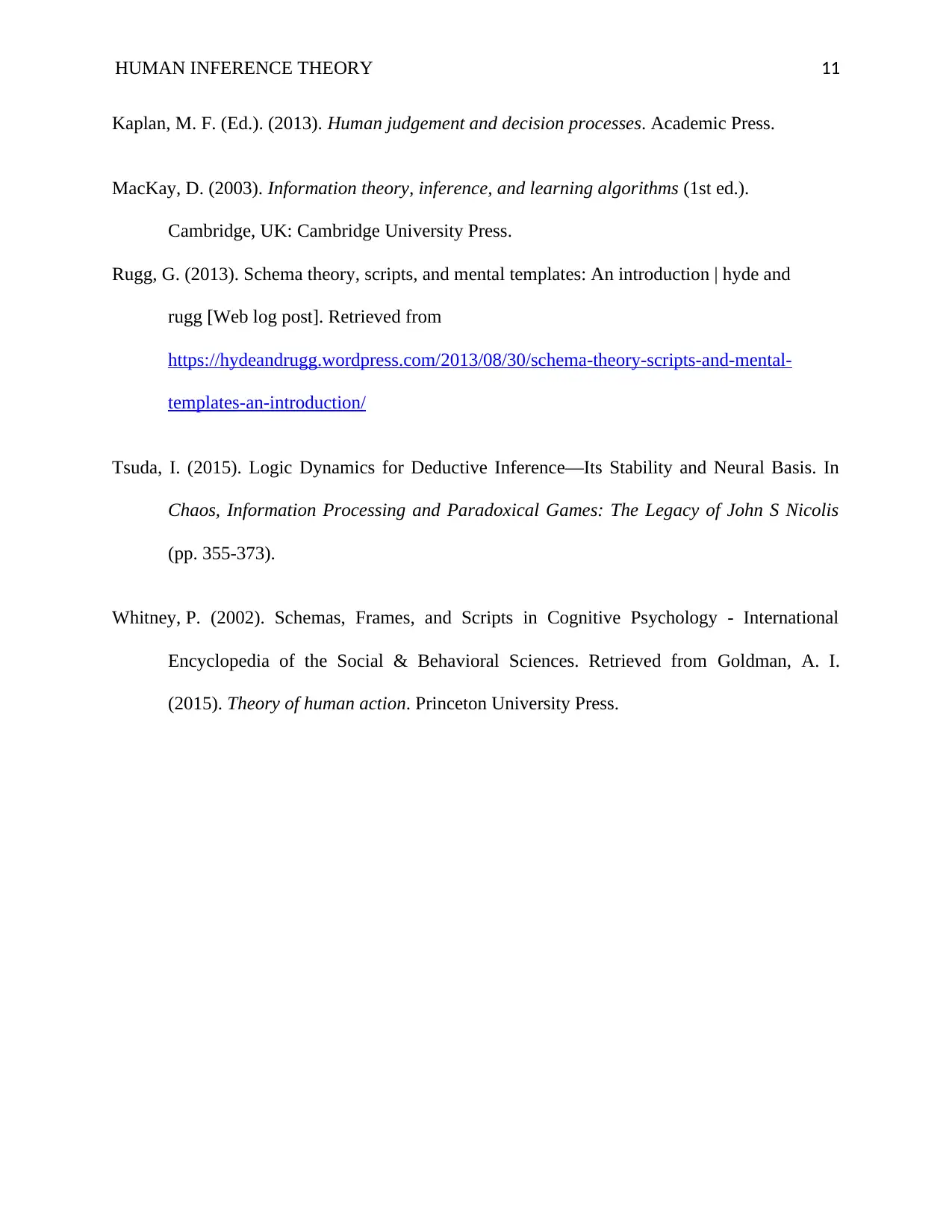
HUMAN INFERENCE THEORY 11
Kaplan, M. F. (Ed.). (2013). Human judgement and decision processes. Academic Press.
MacKay, D. (2003). Information theory, inference, and learning algorithms (1st ed.).
Cambridge, UK: Cambridge University Press.
Rugg, G. (2013). Schema theory, scripts, and mental templates: An introduction | hyde and
rugg [Web log post]. Retrieved from
https://hydeandrugg.wordpress.com/2013/08/30/schema-theory-scripts-and-mental-
templates-an-introduction/
Tsuda, I. (2015). Logic Dynamics for Deductive Inference—Its Stability and Neural Basis. In
Chaos, Information Processing and Paradoxical Games: The Legacy of John S Nicolis
(pp. 355-373).
Whitney, P. (2002). Schemas, Frames, and Scripts in Cognitive Psychology - International
Encyclopedia of the Social & Behavioral Sciences. Retrieved from Goldman, A. I.
(2015). Theory of human action. Princeton University Press.
Kaplan, M. F. (Ed.). (2013). Human judgement and decision processes. Academic Press.
MacKay, D. (2003). Information theory, inference, and learning algorithms (1st ed.).
Cambridge, UK: Cambridge University Press.
Rugg, G. (2013). Schema theory, scripts, and mental templates: An introduction | hyde and
rugg [Web log post]. Retrieved from
https://hydeandrugg.wordpress.com/2013/08/30/schema-theory-scripts-and-mental-
templates-an-introduction/
Tsuda, I. (2015). Logic Dynamics for Deductive Inference—Its Stability and Neural Basis. In
Chaos, Information Processing and Paradoxical Games: The Legacy of John S Nicolis
(pp. 355-373).
Whitney, P. (2002). Schemas, Frames, and Scripts in Cognitive Psychology - International
Encyclopedia of the Social & Behavioral Sciences. Retrieved from Goldman, A. I.
(2015). Theory of human action. Princeton University Press.
1 out of 11
Your All-in-One AI-Powered Toolkit for Academic Success.
+13062052269
info@desklib.com
Available 24*7 on WhatsApp / Email
![[object Object]](/_next/static/media/star-bottom.7253800d.svg)
Unlock your academic potential
Copyright © 2020–2025 A2Z Services. All Rights Reserved. Developed and managed by ZUCOL.
